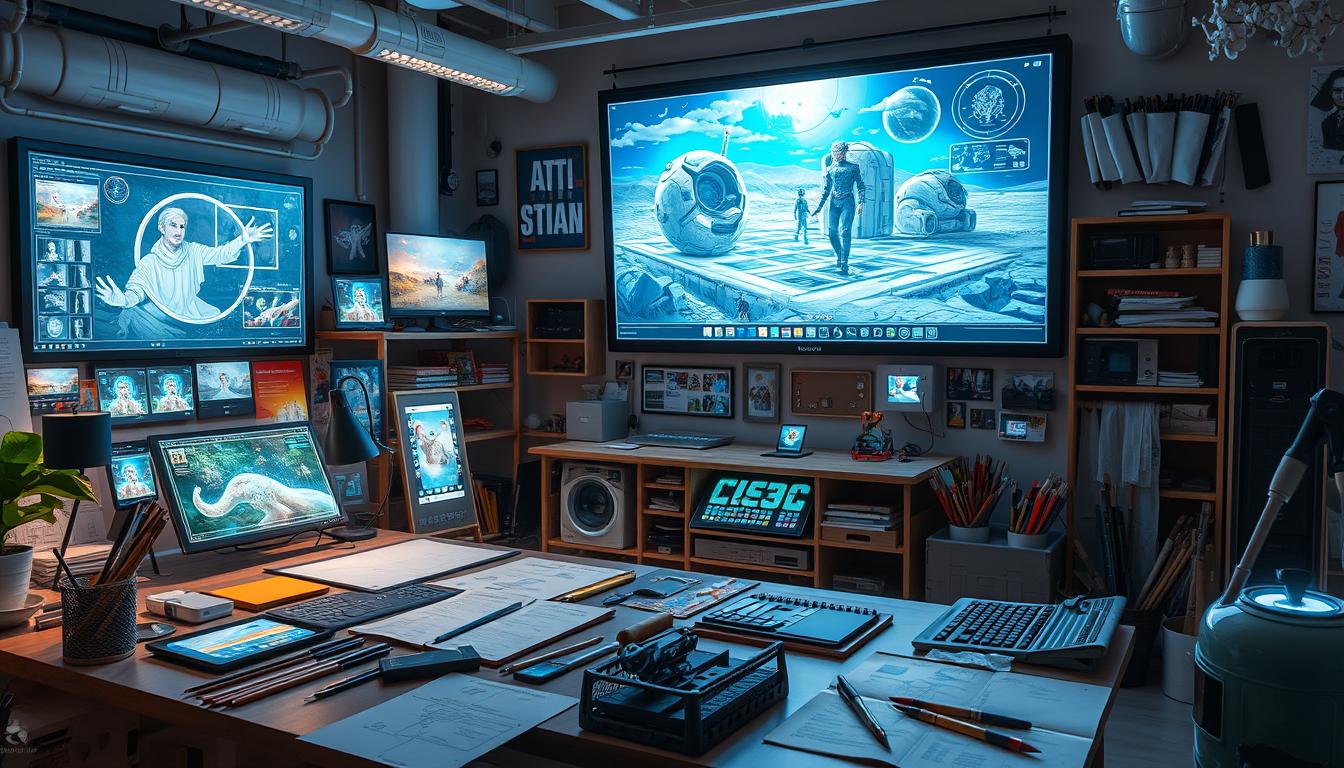AI-powered storyboarding has transformed visual storytelling. This guide will show you how to use AI for creating engaging storyboards. You’ll learn to streamline your workflow and bring your visual narratives to life.
AI can help both beginners and experienced storytellers. It offers new ways to craft compelling narratives. This technology enhances the art of visual storytelling.
Key Takeaways
- AI storyboarding revolutionizes the visual storytelling process
- Discover how to leverage AI technology for captivating storyboards
- Learn the step-by-step guide to AI-powered storyboarding
- Enhance your skills in visual storytelling with AI-assisted tools
- Streamline your storyboarding workflow and bring your narratives to life
Introduction to AI Storyboarding
AI has transformed visual storytelling. AI storyboarding streamlines the creative process and enhances the final product. It opens a new era of AI-powered visual storytelling.
What is AI Storyboarding?
AI storyboarding integrates advanced algorithms into traditional storyboarding. It uses machine learning, natural language processing, and computer vision. These tools help creators visualize narratives and develop characters more efficiently.
Benefits of Using AI for Storyboarding
The use of AI in storyboarding offers many advantages. It can elevate your visual storytelling to new heights.
- Accelerated ideation and prototyping: AI tools generate quick storyboard sketches. This allows creators to explore ideas faster.
- Enhanced creativity: AI systems provide unique perspectives and suggest unconventional visual concepts.
- Improved consistency and aesthetics: AI algorithms ensure visual continuity and maintain stylistic coherence.
- Streamlined collaboration: AI-driven platforms enable seamless teamwork and real-time feedback.
AI storyboarding unlocks new realms of creative expression. It helps storytellers captivate audiences with mesmerizing, AI-powered visual narratives.
Setting Up Your AI Storyboarding Environment
AI technology enhances story creation through digital workspaces. The right AI storyboarding software and tools can optimize your workflow. Familiarize yourself with AI-driven visual tools to maximize their potential.
Explore various AI storyboarding software options with unique features. Popular choices include Storyboard Pro, Celtx, and StudioBinder. These integrate AI functionalities to streamline your storyboarding process.
Choose the AI storyboarding software that fits your needs best. Customize your workspace by arranging your digital canvas. Organize your assets and learn the tool’s features and shortcuts.
| AI Storyboarding Software | Key Features | Pricing |
|---|---|---|
| Storyboard Pro | – AI-powered panel and shot suggestions – Realistic 3D character animation – Collaborative storyboarding tools |
$29.99/month or $299/year |
| Celtx | – AI-assisted scriptwriting and storyboarding – Project management and collaboration tools – Integrated media library |
$15.99/month or $149/year |
| StudioBinder | – AI-driven shot and angle recommendations – Virtual storyboarding with 3D cameras – Teamwork and review features |
$49/month or $348/year |
A well-set AI storyboarding environment paves the way for stunning stories. AI technology empowers you to create visually cohesive narratives. Your carefully prepared workspace will boost your creative process.
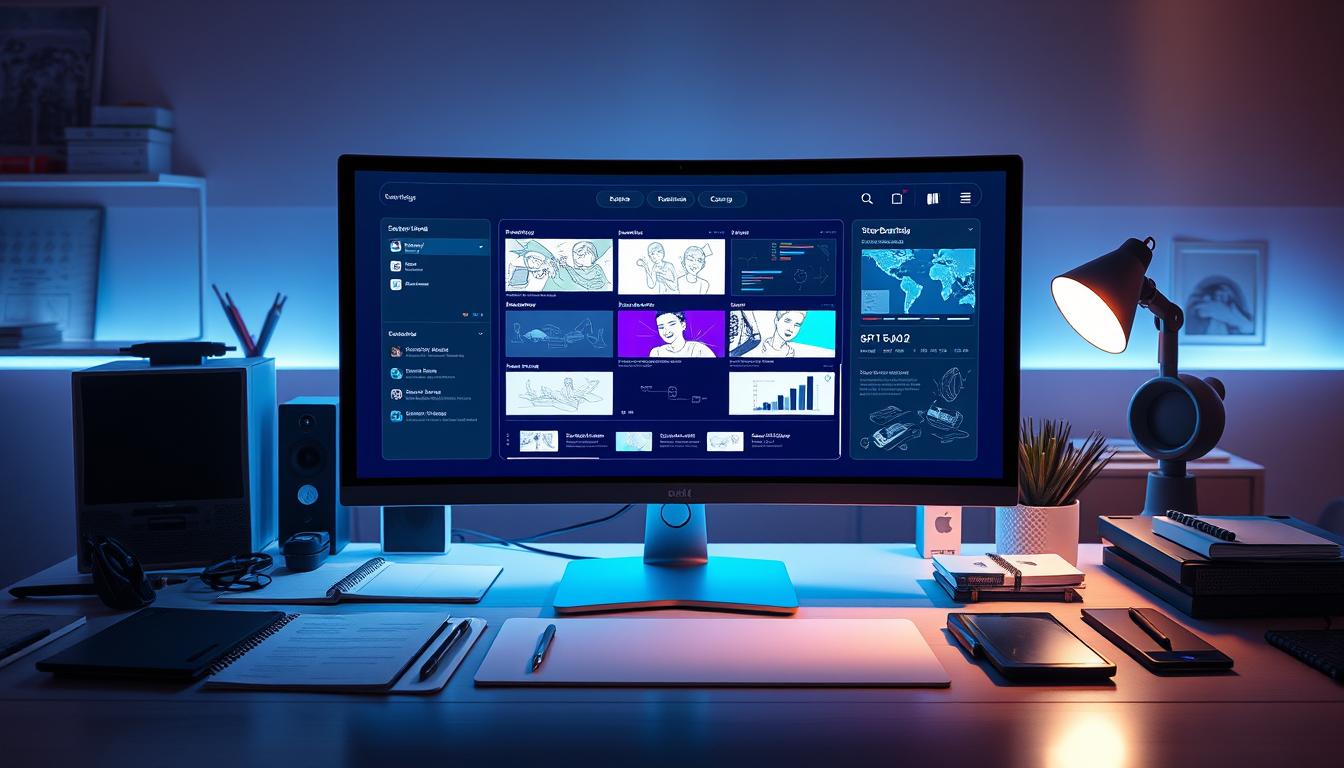
AI Storyboarding for Beginners
AI storyboarding tools offer exciting features for new creators. These tools help bring your creative ideas to life. They streamline your workflow and open up new possibilities in visual storytelling.
Understanding AI Storyboarding Tools
AI storyboarding tools use advanced algorithms to automate parts of the process. They can generate scene ideas and refine character designs quickly. These tools also help with layouting panels efficiently.
Popular AI storyboarding tools often include useful features. They can generate scenes from scripts or prompts. Many offer character design and animation tools too.
You’ll find intuitive panel layout and camera framing options. Some tools have collaborative features for team projects. Many integrate smoothly with digital art software.
Choosing the Right AI Software
Selecting the right AI storyboarding software depends on your needs. Consider your project requirements and skill level as a beginner. Key factors to keep in mind include ease of use and features.
Look for tools with an intuitive interface and gentle learning curve. Evaluate the tool’s capabilities to ensure they match your creative vision. Check if the software works well with your existing digital art tools.
If you plan to work with a team, look for collaboration features. These may include real-time editing and version control. Choosing the right software can boost your creative process significantly.
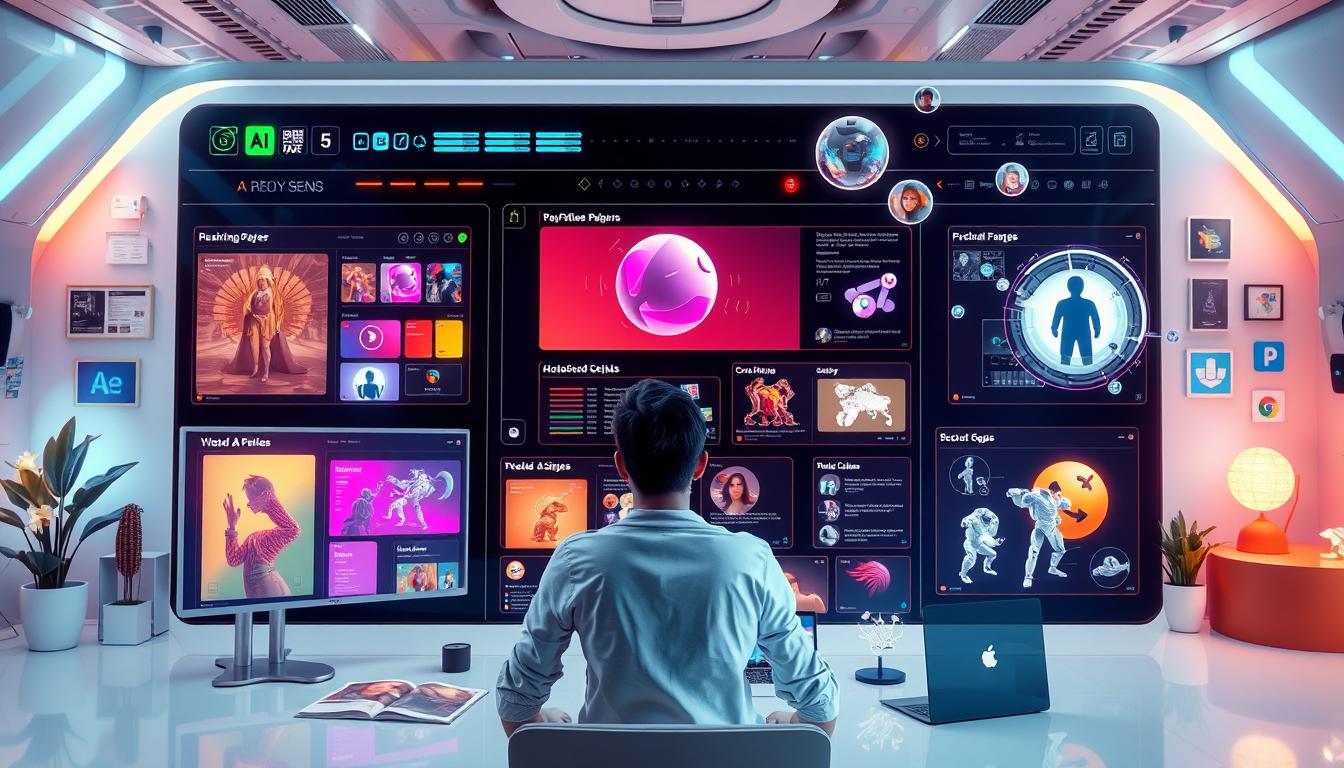
Creating a Compelling Story with AI
AI-assisted tools have transformed storyboarding. They empower writers and artists to craft captivating narratives with ease. These tools unlock new possibilities in character development and plot generation.
Developing Characters with AI
AI-driven character creation tools are invaluable in storyboarding. They bring characters to life with depth, personality, and distinct traits. Machine learning algorithms generate detailed profiles, including backstories and motivations.
AI-assisted development lets you explore diverse character archetypes. You can experiment with different personalities and fine-tune characters. This helps create rich, multidimensional characters that captivate audiences.
AI-Driven Plot Generation
AI plays a transformative role in plot generation. Advanced algorithms analyze narrative structures and identify compelling storylines. They generate innovative plot points that breathe life into storyboards.
AI-powered tools tap into narrative tropes and storytelling techniques. They help construct intricate, twisting plots that keep audiences engaged. From unexpected twists to character arcs, AI enhances your storyboarding process.
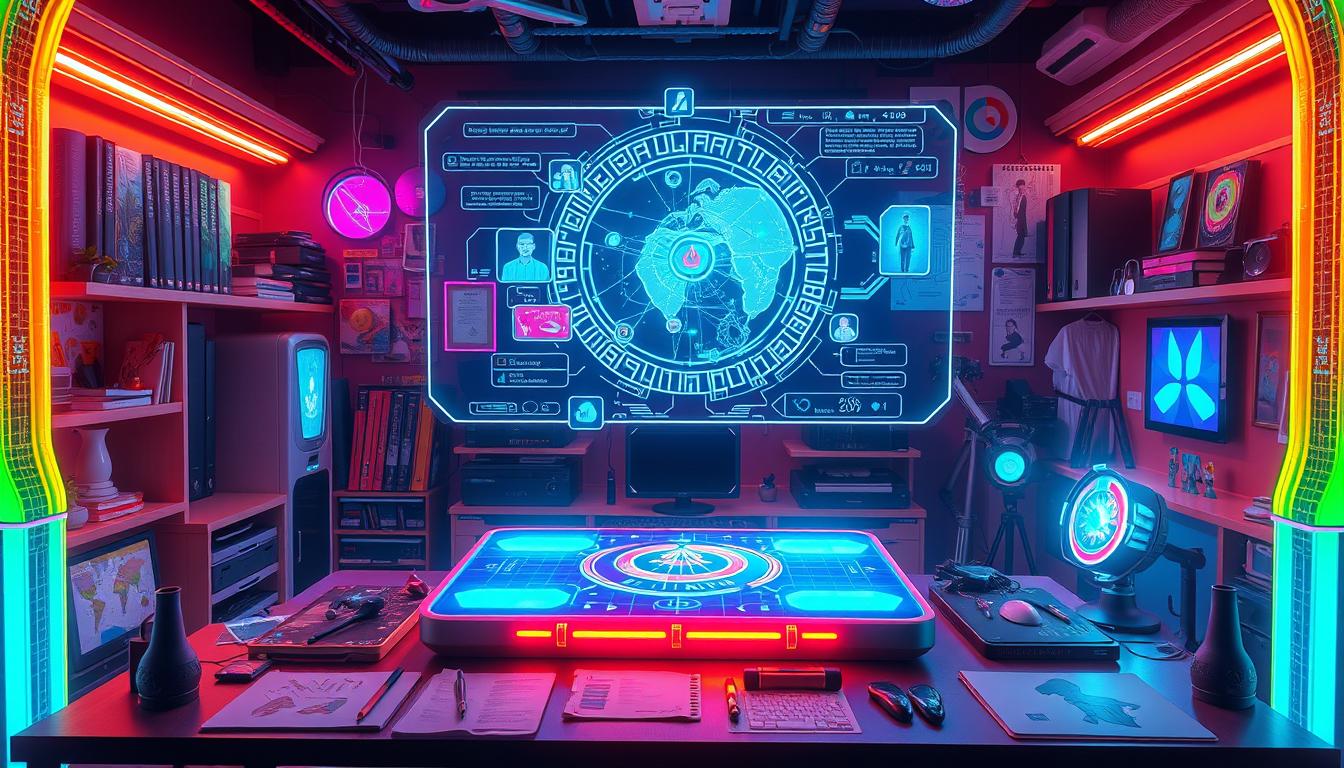
“AI has transformed the way we approach storytelling, empowering us to create characters and plots that are more nuanced, dynamic, and engaging than ever before.”
Visualizing Your Story with AI
AI has transformed story creation and visualization. It enables captivating visual experiences through AI-generated storyboards and visual narratives. Let’s explore how to use AI technologies to bring your creative visions to life.
Generating Compelling Visuals
AI tools can create various visual assets for your story. These include character designs, scene backdrops, and dynamic panel layouts. You can input story elements and get diverse visual options to experiment with.
This allows you to refine your narrative’s visual identity. AI-driven systems produce multiple choices, enhancing your creative process.
Manipulating and Refining Visuals
AI-generated visuals serve as a starting point for your creativity. AI-based image editing tools help customize and refine these visuals. You can adjust colors, modify compositions, and fine-tune storyboard panel details.
These tools ensure a cohesive and visually stunning narrative. They allow you to align the visuals with your creative vision.
Sequencing and Storytelling
AI-powered tools help organize and sequence your visual assets. They create a compelling narrative flow for your story. AI algorithms analyze story elements and suggest panel arrangements, pacing, and transitions.
This assistance helps craft an engaging and immersive storytelling experience. It enhances the visual appeal of your narrative.
| Feature | Description |
|---|---|
| AI-Generated Visuals | Produce a wide range of visual assets, including character designs, scene backdrops, and panel layouts. |
| Visual Customization | Refine and manipulate the generated visuals to align with your creative vision. |
| Narrative Sequencing | Organize and sequence your visual assets to create a compelling and visually engaging storytelling experience. |
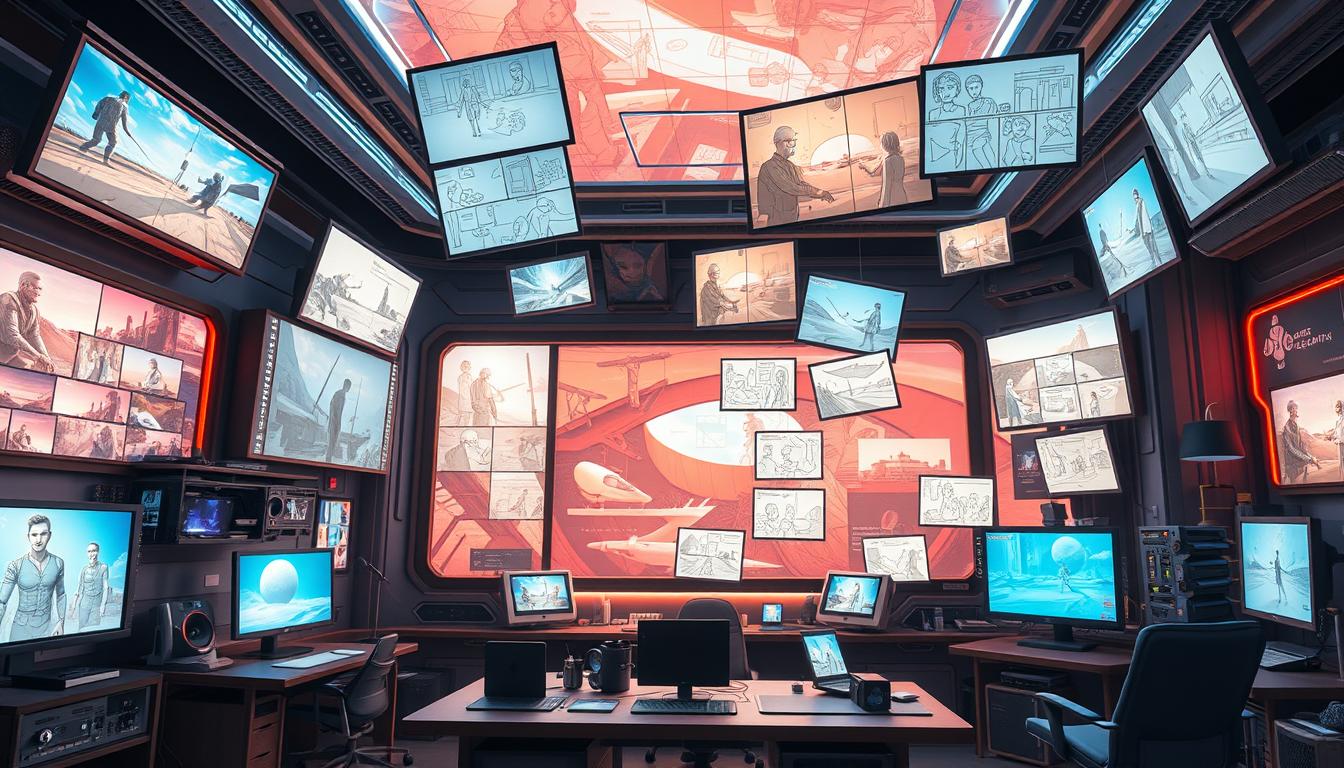
AI-generated storyboards and visual narratives unleash creativity. They bring stories to life in captivating ways. Embrace this technology to elevate your storytelling to new heights.
Refining and Editing Your AI-Generated Storyboards
After creating AI-generated storyboards, it’s time to refine and edit them. This step ensures your final product is polished and production-ready.
Reviewing and Revising Storyboards
Carefully review your AI-generated storyboards for inconsistencies and plot holes. Look for areas that need more development or clarity.
Check if the story flows logically between scenes. Ensure characters are well-developed and believable. Verify that visual elements engage viewers and align with the narrative.
Make notes on areas needing refinement. Use AI storyboarding tools to adjust and improve your storyboards.
Incorporating Feedback
Seeking feedback is vital for refining AI storyboards. Share your work with colleagues, clients, or stakeholders to gather insights.
Listen to their comments and suggestions. They can help identify areas for improvement and assist in editing AI-generated storyboards.
Be open to constructive criticism. Use it to incorporate feedback into AI storyboarding. Revise while preserving your story’s core.
Through careful review and feedback incorporation, you can refine AI storyboards. This process creates a compelling final product that resonates with your audience.
Collaborating with a Team Using AI Storyboarding
AI storyboarding tools streamline team collaboration in creative storytelling. These tools enable seamless teamwork for team-based AI storyboarding and sharing AI-generated storyboards. This section guides you through essential steps for effective collaboration.
Collaborative AI storyboarding centralizes creative assets for teams. Cloud-based platforms allow real-time access, review, and refinement of storyboards. This approach eliminates disorganized file-sharing and streamlines the creative process.
Many AI storyboarding tools offer robust collaboration features. These include commenting, versioning, and approval workflows. Such features enable team feedback, change suggestions, and storyboard evolution tracking.
Sharing AI-generated storyboards with stakeholders can be transformative. It presents work visually and interactively. This method helps gather valuable feedback and aligns project direction.
Collaborative AI storyboarding boosts creativity and efficiency for teams. It harnesses AI and cloud-based collaboration power. This approach unlocks new possibilities in storytelling journeys.
Best Practices for AI Storyboarding
AI storyboarding offers exciting possibilities for creators. Let’s explore some best practices to boost your storytelling skills. These tips will help you create better storyboards and improve your workflow.
Tips and Tricks for Effective AI Storyboarding
Keep up with the latest AI storyboarding tools. Try different software to find what fits your creative style best. This will help you use the most innovative features.
Focus on creating strong characters and engaging plots. Use AI tools to generate unique characters and realistic dialogue. Refine your work until it has the right emotional impact.
Team up with others to improve your storyboards. Use AI collaboration tools to make reviewing and revising easier. This approach ensures your final product reflects everyone’s best ideas.
